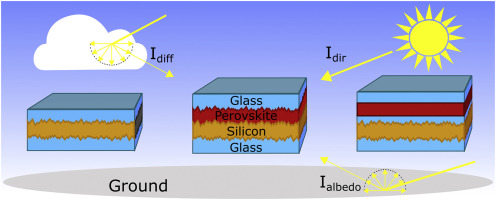当前位置:
X-MOL 学术
›
Sol. Energy Mater. Sol. Cells
›
论文详情
Our official English website, www.x-mol.net, welcomes your feedback! (Note: you will need to create a separate account there.)
Energy yield of bifacial textured perovskite/silicon tandem photovoltaic modules
Solar Energy Materials and Solar Cells ( IF 6.9 ) Pub Date : 2020-05-01 , DOI: 10.1016/j.solmat.2019.110367 Jonathan Lehr , Malte Langenhorst , Raphael Schmager , Fabrizio Gota , Simon Kirner , Uli Lemmer , Bryce S. Richards , Chris Case , Ulrich W. Paetzold
Solar Energy Materials and Solar Cells ( IF 6.9 ) Pub Date : 2020-05-01 , DOI: 10.1016/j.solmat.2019.110367 Jonathan Lehr , Malte Langenhorst , Raphael Schmager , Fabrizio Gota , Simon Kirner , Uli Lemmer , Bryce S. Richards , Chris Case , Ulrich W. Paetzold

|
Abstract Bifacial perovskite/crystalline silicon (c-Si) tandem photovoltaic (PV) modules that harvest albedo radiation are a promising strategy to further enhance the energy yield (EY) of monofacial perovskite/c-Si tandem PV modules. Given the required current matching in bifacial perovskite/c-Si two-terminal (2T) tandem PV modules, predicting the expected enhancement in EY requires an advanced EY modelling framework. In this study, the architecture, module tilt, perovskite absorber layer thickness, and bandgap of the perovskite top solar cell are optimized for several types of grounds and two locations. Compared to bifacial c-Si single-junction PV modules, the relative enhancement in EY of textured bifacial perovskite/c-Si 2T tandem PV modules is around 24–38% for an exemplary grass ground (mean albedo = 35%). With increasing albedo, the optimum bandgap of the perovskite top solar cell decreases from 1.72 eV (black ground, mean albedo = 0%) to 1.55 eV (snow, mean albedo = 88%). This is attributed to enhanced current generation only in the c-Si bottom solar cell due to albedo radiation, entering the solar cell at the rear side. In addition, minor optical losses due to ground shading are found for modules with a finite mounting height in the range of 1 m. Overall, our study highlights the importance of EY modelling to assess the performance of bifacial perovskite/c-Si tandem PV. It provides direction for the design of bifacial perovskite/c-Si tandem solar cells with regard to the device architecture and the choice of the perovskite material with regard to its bandgap.
中文翻译:

双面织构钙钛矿/硅串联光伏组件的能量产率
摘要 收获反照率辐射的双面钙钛矿/晶体硅 (c-Si) 串联光伏 (PV) 模块是进一步提高单面钙钛矿/c-Si 串联光伏组件能量产率 (EY) 的有前途的策略。鉴于双面钙钛矿/c-Si 两端 (2T) 串联 PV 模块所需的电流匹配,预测 EY 的预期增强需要先进的 EY 建模框架。在这项研究中,钙钛矿顶部太阳能电池的结构、模块倾斜度、钙钛矿吸收层厚度和带隙针对几种类型的地面和两个位置进行了优化。与双面 c-Si 单结光伏组件相比,对于示例性草地(平均反照率 = 35%),纹理双面钙钛矿/c-Si 2T 串联光伏组件的 EY 相对增强约为 24-38%。随着反照率的增加,钙钛矿顶部太阳能电池的最佳带隙从 1.72 eV(黑地,平均反照率 = 0%)降低到 1.55 eV(雪,平均反照率 = 88%)。这归因于仅在 c-Si 底部太阳能电池中由于反照率辐射而增强的电流产生,从背面进入太阳能电池。此外,对于有限安装高度在 1 m 范围内的模块,发现由于地面遮蔽导致的轻微光损耗。总的来说,我们的研究强调了 EY 建模对评估双面钙钛矿/c-Si 串联光伏性能的重要性。它为双面钙钛矿/c-Si 串联太阳能电池在器件结构和钙钛矿材料的选择方面的带隙设计提供了方向。平均反照率 = 88%)。这归因于仅在 c-Si 底部太阳能电池中由于反照率辐射而增强的电流产生,从背面进入太阳能电池。此外,对于有限安装高度在 1 m 范围内的模块,发现由于地面遮蔽导致的轻微光损耗。总的来说,我们的研究强调了 EY 建模对评估双面钙钛矿/c-Si 串联光伏性能的重要性。它为双面钙钛矿/c-Si 串联太阳能电池在器件结构和钙钛矿材料的选择方面的带隙设计提供了方向。平均反照率 = 88%)。这归因于仅在 c-Si 底部太阳能电池中由于反照率辐射而增强的电流产生,从背面进入太阳能电池。此外,对于有限安装高度在 1 m 范围内的模块,发现由于地面遮蔽导致的轻微光损耗。总的来说,我们的研究强调了 EY 建模对评估双面钙钛矿/c-Si 串联光伏性能的重要性。它为双面钙钛矿/c-Si 串联太阳能电池在器件结构和钙钛矿材料的选择方面的带隙设计提供了方向。对于有限安装高度在 1 m 范围内的模块,发现由于地面遮蔽导致的轻微光损耗。总的来说,我们的研究强调了 EY 建模对评估双面钙钛矿/c-Si 串联光伏性能的重要性。它为双面钙钛矿/c-Si 串联太阳能电池在器件结构和钙钛矿材料的选择方面的带隙设计提供了方向。对于有限安装高度在 1 m 范围内的模块,发现由于地面遮蔽导致的轻微光损耗。总的来说,我们的研究强调了 EY 建模对评估双面钙钛矿/c-Si 串联光伏性能的重要性。它为双面钙钛矿/c-Si 串联太阳能电池在器件结构和钙钛矿材料的选择方面的带隙设计提供了方向。
更新日期:2020-05-01
中文翻译:

双面织构钙钛矿/硅串联光伏组件的能量产率
摘要 收获反照率辐射的双面钙钛矿/晶体硅 (c-Si) 串联光伏 (PV) 模块是进一步提高单面钙钛矿/c-Si 串联光伏组件能量产率 (EY) 的有前途的策略。鉴于双面钙钛矿/c-Si 两端 (2T) 串联 PV 模块所需的电流匹配,预测 EY 的预期增强需要先进的 EY 建模框架。在这项研究中,钙钛矿顶部太阳能电池的结构、模块倾斜度、钙钛矿吸收层厚度和带隙针对几种类型的地面和两个位置进行了优化。与双面 c-Si 单结光伏组件相比,对于示例性草地(平均反照率 = 35%),纹理双面钙钛矿/c-Si 2T 串联光伏组件的 EY 相对增强约为 24-38%。随着反照率的增加,钙钛矿顶部太阳能电池的最佳带隙从 1.72 eV(黑地,平均反照率 = 0%)降低到 1.55 eV(雪,平均反照率 = 88%)。这归因于仅在 c-Si 底部太阳能电池中由于反照率辐射而增强的电流产生,从背面进入太阳能电池。此外,对于有限安装高度在 1 m 范围内的模块,发现由于地面遮蔽导致的轻微光损耗。总的来说,我们的研究强调了 EY 建模对评估双面钙钛矿/c-Si 串联光伏性能的重要性。它为双面钙钛矿/c-Si 串联太阳能电池在器件结构和钙钛矿材料的选择方面的带隙设计提供了方向。平均反照率 = 88%)。这归因于仅在 c-Si 底部太阳能电池中由于反照率辐射而增强的电流产生,从背面进入太阳能电池。此外,对于有限安装高度在 1 m 范围内的模块,发现由于地面遮蔽导致的轻微光损耗。总的来说,我们的研究强调了 EY 建模对评估双面钙钛矿/c-Si 串联光伏性能的重要性。它为双面钙钛矿/c-Si 串联太阳能电池在器件结构和钙钛矿材料的选择方面的带隙设计提供了方向。平均反照率 = 88%)。这归因于仅在 c-Si 底部太阳能电池中由于反照率辐射而增强的电流产生,从背面进入太阳能电池。此外,对于有限安装高度在 1 m 范围内的模块,发现由于地面遮蔽导致的轻微光损耗。总的来说,我们的研究强调了 EY 建模对评估双面钙钛矿/c-Si 串联光伏性能的重要性。它为双面钙钛矿/c-Si 串联太阳能电池在器件结构和钙钛矿材料的选择方面的带隙设计提供了方向。对于有限安装高度在 1 m 范围内的模块,发现由于地面遮蔽导致的轻微光损耗。总的来说,我们的研究强调了 EY 建模对评估双面钙钛矿/c-Si 串联光伏性能的重要性。它为双面钙钛矿/c-Si 串联太阳能电池在器件结构和钙钛矿材料的选择方面的带隙设计提供了方向。对于有限安装高度在 1 m 范围内的模块,发现由于地面遮蔽导致的轻微光损耗。总的来说,我们的研究强调了 EY 建模对评估双面钙钛矿/c-Si 串联光伏性能的重要性。它为双面钙钛矿/c-Si 串联太阳能电池在器件结构和钙钛矿材料的选择方面的带隙设计提供了方向。


























 京公网安备 11010802027423号
京公网安备 11010802027423号